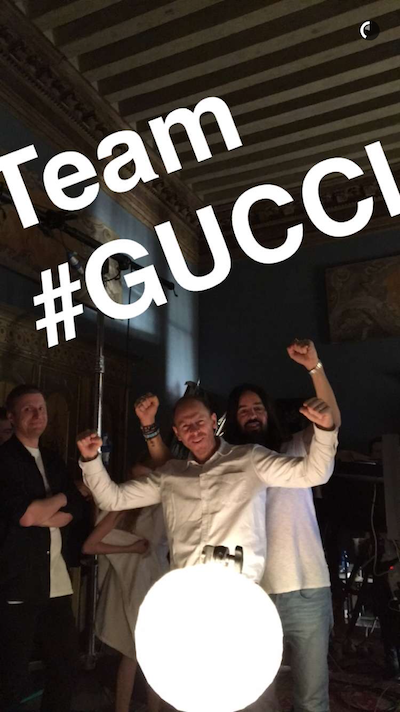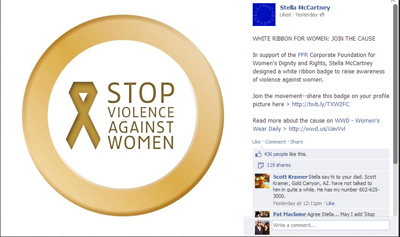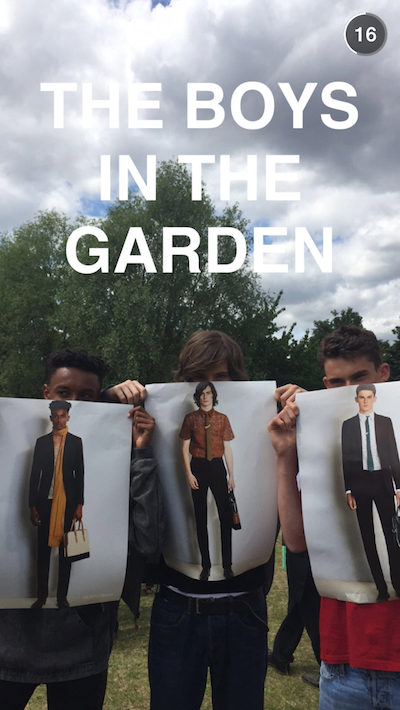 Promotional image for Burberry's Snapchat Show
Promotional image for Burberry's Snapchat Show
In the fashion world, brands that receive the most buzz and see results from marketing and publicity online are often times luxury labels, according to a new report by Fashionbi.
Fashionbi looked at the buzz generated by social media posts and actions to calculate an index score measuring the effectiveness of a brand’s marketing in 2015. In France and Italy in particular, luxury brands were the highest scorers.
“Fashionbi Index is a quantitative measure of brand considerations online," said Ambika Zutshi, CEO of Fashionbi, Milan. "It is highly consumer-driven.
"More than what a brand is doing, it goes up accordingly to how consumers perceive it," she said. "Sure, the brand needs to, first of all, have a good presence online, be frequent and innovative in its communication, etc., but it will achieve a high score in our index only if it appeals enough to the people in order for them to speak about it.
“For instance, Chanel is a winner amongst French brands in Fashionbi Index Book 2015; however, if you look at its activities, especially on social media, it does far less than the competitors. Yet the power of its branding is such that even with one post, the brand is able to gain immense engagement."
"Fashionbi Index Book 2015" evaluates on a quantitative scale the digital efforts of and events surrounding a brand. Social media activity and the social impact of external publicity, including negative scandals, are put through an algorithm to generate a number, with brands then ranked against others from the same country.
Good publicity
Louis Vuitton’s index score of 179.70 was ahead of Dior’s second place 157.51, itself a notable improvement over Louboutin’s 121.46, good for third. Of the top 10 brands, only LVMH-owned Sephora and Lacoste are not luxury fashion houses.
In Italy, the top brands also skewed heavily toward luxury. Dolce & Gabbana beat out Ferrari for the top spot, with Gucci and Armani behind. Versace, Valentino, Roberto Cavalli and Prada all placed in the top 10, with several more luxury brands in the top 20.
In the UK, luxury did not have such an obvious reign, although Burberry beat its closest competitor by 56.5 points. Rolex and Jimmy Choo finished within the top 10.
 Gucci Snapchat from Jared Leto takeover
Luxury was far less present in the United States. Alexander Wang placed first, with Michael Kors in third and Tiffany & Co. in ninth. Marc Jacobs was only fourteenth, while Nordstrom, Neiman Marcus, Ralph Lauren and Calvin Klein finished outside the top 20.
Luxury brands are traditionally thought of as being slow adopters of technology and criticized for being inadequate in the digital space. While the results do not necessarily prove that this is not the case, they do indicate luxury brands have generated significant buzz online.
This could be a result of creative and timely marketing strategies, or due to dedicated fanbases or a tendency among consumers in certain locations and/or of certain levels of affluence to interact with brands on social media.
In addition to rankings, the book looks at a range of different ways that contributed to strong index scores.
Cartier, ranked sixth among French brands, posted about exhibitions and museums to generate buzz that translated to physical engagement. During SIHH in 2015, the brand exclusively presented new horological creations. Social media channels were constantly flooded with pictures of the brand’s merchandise.
Sometimes bad news did just as much to get a brand noticed as good news. The Hermès PETA scandal (see story) caused a spike in awareness for the brand. Counteracting the bad news, organizing the Saut Hermès au Grand Palais led to even more engagement, and the collaboration with Apple in September was another big hit for the iconic brand.
Burberry was a runaway winner among UK brands, and its shift in focus online, from targeting everyone to targeting millennials, likely played a part. Burberry was an early and frequent user of Snapchat and Periscope, and unexpected collaborations kept fans on their toes.
Gucci Snapchat from Jared Leto takeover
Luxury was far less present in the United States. Alexander Wang placed first, with Michael Kors in third and Tiffany & Co. in ninth. Marc Jacobs was only fourteenth, while Nordstrom, Neiman Marcus, Ralph Lauren and Calvin Klein finished outside the top 20.
Luxury brands are traditionally thought of as being slow adopters of technology and criticized for being inadequate in the digital space. While the results do not necessarily prove that this is not the case, they do indicate luxury brands have generated significant buzz online.
This could be a result of creative and timely marketing strategies, or due to dedicated fanbases or a tendency among consumers in certain locations and/or of certain levels of affluence to interact with brands on social media.
In addition to rankings, the book looks at a range of different ways that contributed to strong index scores.
Cartier, ranked sixth among French brands, posted about exhibitions and museums to generate buzz that translated to physical engagement. During SIHH in 2015, the brand exclusively presented new horological creations. Social media channels were constantly flooded with pictures of the brand’s merchandise.
Sometimes bad news did just as much to get a brand noticed as good news. The Hermès PETA scandal (see story) caused a spike in awareness for the brand. Counteracting the bad news, organizing the Saut Hermès au Grand Palais led to even more engagement, and the collaboration with Apple in September was another big hit for the iconic brand.
Burberry was a runaway winner among UK brands, and its shift in focus online, from targeting everyone to targeting millennials, likely played a part. Burberry was an early and frequent user of Snapchat and Periscope, and unexpected collaborations kept fans on their toes.
 Stella McCartney Facebook post
Stella McCartney, meanwhile, saw success standing up for its stated values: social responsibility, from environmental protection to violence against women and animal rights.
Whether through showcasing positive values, creating desire or even coming under fire, any kind of awareness can work in a brand’s favor.
“As established analysts and consultants in the marketing business for fashion brands for a few years now, we can safely say that any kind of publicity sooner or later pays off well for the brands,” Ms. Zutshi said. “If not revenues, their buzz online increases and the word instantly spreads amongst a ton of people worldwide, more than what a brand could have reached organically.
"Then, when the brand comes back into action with a charitable cause or such, those same people who already got to know it will recognize it and appreciate its efforts,” she said.
From impressions to revenue
Fashionbi has previously found that social media has a big impact on revenue.
Social media has become an integral aspect of fashion marketing, with the 56 percent of consumers following branded accounts likely to spend more on purchases than those who do not, according to a prior report by Fashionbi.
A social media presence is just one aspect of an omnichannel strategy, a consumer journey that bridges online and offline interactions ripe with content, experience and high-end service to spur purchase decisions. Omnichannel has become a signifier for “exceptional” brands, but Fashionbi’s “Mystery Shopping: Are the brands really able to omni-market, as they claim?” report looks to determine the actuality of the practice (see story).
This does not mean flooding consumers’ feeds with content is the correct approach. Although social media platforms by their nature require volume, the content must also be strong.
Stella McCartney Facebook post
Stella McCartney, meanwhile, saw success standing up for its stated values: social responsibility, from environmental protection to violence against women and animal rights.
Whether through showcasing positive values, creating desire or even coming under fire, any kind of awareness can work in a brand’s favor.
“As established analysts and consultants in the marketing business for fashion brands for a few years now, we can safely say that any kind of publicity sooner or later pays off well for the brands,” Ms. Zutshi said. “If not revenues, their buzz online increases and the word instantly spreads amongst a ton of people worldwide, more than what a brand could have reached organically.
"Then, when the brand comes back into action with a charitable cause or such, those same people who already got to know it will recognize it and appreciate its efforts,” she said.
From impressions to revenue
Fashionbi has previously found that social media has a big impact on revenue.
Social media has become an integral aspect of fashion marketing, with the 56 percent of consumers following branded accounts likely to spend more on purchases than those who do not, according to a prior report by Fashionbi.
A social media presence is just one aspect of an omnichannel strategy, a consumer journey that bridges online and offline interactions ripe with content, experience and high-end service to spur purchase decisions. Omnichannel has become a signifier for “exceptional” brands, but Fashionbi’s “Mystery Shopping: Are the brands really able to omni-market, as they claim?” report looks to determine the actuality of the practice (see story).
This does not mean flooding consumers’ feeds with content is the correct approach. Although social media platforms by their nature require volume, the content must also be strong.
 Burberry fall/winter 2015 Periscope
Any brand can create a social media account, but using these platforms to create a natural extension of the label and leverage social clout to generate sales and loyalty is another matter, according to a speaker at Luxury Interactive 2015 on Oct. 13.
Social media has shrunk the distance between brands and consumers, but bringing these parties closer together has also destroyed traditional business/customer relationships. To be successful on social media, consumers need to be treated like equals and people, otherwise social presence could, counterproductively, push consumers to competition (see story).
“A major part of the Fashionbi Index algorithm is formulated using the online and social media analytics around the brands (brand activity, mentions, followers, engagement, impact, etc.)," Ms. Zutshi said. "In previous research, we found a correlation between a brand's social media trends and its market value.
“Interestingly, for many brands, such a trend continues," she said. "If a brand receives a high index score in a period, it means its popularity and consideration in the period increased and this can directly or indirectly impact positively on brand's awareness online even if the considerations are negative and on its revenues if they are for positive reasons."
“In both situations, a brand needs to react smartly, in order to turn such considerations into positive opportunities.”
Burberry fall/winter 2015 Periscope
Any brand can create a social media account, but using these platforms to create a natural extension of the label and leverage social clout to generate sales and loyalty is another matter, according to a speaker at Luxury Interactive 2015 on Oct. 13.
Social media has shrunk the distance between brands and consumers, but bringing these parties closer together has also destroyed traditional business/customer relationships. To be successful on social media, consumers need to be treated like equals and people, otherwise social presence could, counterproductively, push consumers to competition (see story).
“A major part of the Fashionbi Index algorithm is formulated using the online and social media analytics around the brands (brand activity, mentions, followers, engagement, impact, etc.)," Ms. Zutshi said. "In previous research, we found a correlation between a brand's social media trends and its market value.
“Interestingly, for many brands, such a trend continues," she said. "If a brand receives a high index score in a period, it means its popularity and consideration in the period increased and this can directly or indirectly impact positively on brand's awareness online even if the considerations are negative and on its revenues if they are for positive reasons."
“In both situations, a brand needs to react smartly, in order to turn such considerations into positive opportunities.”
